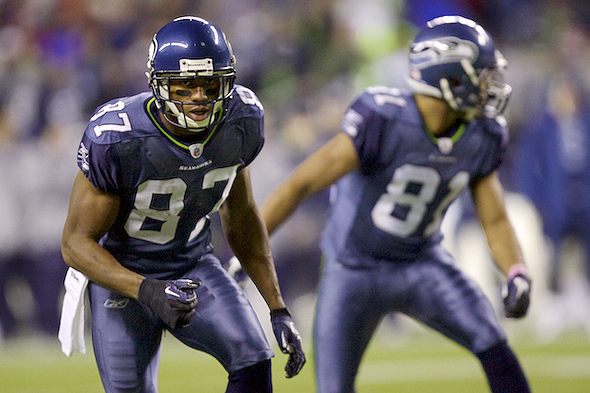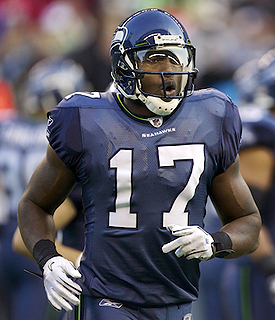
When Seahawks general manager John Schneider took over a bloated, ineffective roster in January of 2010, one of the first things he turned his attention to was the wide receiver position.
Deion Branch and T.J. Houshmandzadeh, signed to contracts by Tim Ruskell that totaled almost $80 million in absolute value, combined in 2009 for 124 catches for 1,348 yards and five touchdowns. To put that into perspective, Branchs old New England teammate Wes Welker caught 123 passes for 1,348 yards and four scores all on his own and Welker is the Patriots possession receiver.
Soon enough, Branch and Houshmandzadeh were gone to New England and Baltimore, respectively their fates tied inexorably to every other player who wouldnt buy in to Pete Carrolls program.
To replace the former primary receivers, Carroll and Schneider promoted the formerly underused Ben Obomanu and Deon Butler, and took Mike Williams off the scrap heap. The results werent overwhelming Williams led the team with 751 yards and two touchdowns on 65 catches but Seattles receiver corps got younger, cheaper, hungrier, and more effective for the long term. Theres still a long way to go with this Seattle offense, but the one-year overhaul (so typical of the Killing Fields personnel approach adopted by Schneider and Carroll) set a tone for a new group of Seahawks receivers.
The question is: who will be there doing what when the smoke clears?
Mike Williams
Out of football for two full seasons after busting out of Detroit and blowing up to 270 pounds with the Oakland Raiders and Tennessee Titans, Williams, who was last an efficient receiver under Carroll at USC in 2002 and 2003, brought his playing weight back down and came to Seattle under the most humble circumstances possible from mini-camp walk-on, to training camp reclamation project, to preseason starter, to regular season linchpin. Hungry as he had never been before, Williams grabbed his second chance with maximum intensity and became Matt Hasselbecks first reliable big target since Joe Jurevicius in 2005.

At 6-foot-5 and 235 pounds, Williams beat defenders up on short routes, proved to be a demon after the catch, and contorted his body to catch Hasselbecks sometimes errant throws with coverage all around him. Williams was at his best against the Arizona Cardinals two separate 11-catch games in which he was the difference in a second sweep and the Seahawks lost the two games in which he didnt play. Williams received a four-year, $11.74 million contract extension in early January, and though he doesnt have the pure speed to separate from defensive backs as most number-one receivers, hes unquestionably a key part of the Seahawks offensive plans going forward, especially as the team switched back to the West Coast offense in which consistency is more important than explosiveness.
Williams also finished second in the NFLs Comeback Player of the Year award to Michael Vick, though its not really clear what Williams ever came back from. In effect, his career is just beginning.
Ben Obomanu
Before this season, Obomanu was primarily a special-teams afterthought, though he finally got his shot when Branch and Houshmandzadeh took their leave. The Auburn alum proved to be excellent in traffic and short spaces, showing dynamism in the slants and crossing routes so important to any offense. He led the team with a 16.5 yards-per-catch average among all receivers with at least 10 catches, and caught an 87-yard touchdown pass in his five-catch, 159-yard game against the Kansas City Chiefs. As with Williams, Obomanu should find that his knack for getting open in traffic will serve him well in Seattles return to the West Coast offense.
Deon Butler
The speedster in the group, Butler went from breaking Bobby Engrams records at Penn State to a role as an ancillary afterthought in Greg Knapps schemes in 2009. Given room to move in 2010, it was thought that his downfield burst would be a perfect fit with Jeremy Bates vertical offense. But he struggled to find his place, catching just 36 of the 70 passes thrown to him, and he broke his leg in Week 14 that ended his season.
After Branch was traded, many of the young receivers cited Stokley as the mentor of the group. Stokley provided what was expected of him consistent production when he was called upon (31 catches in 43 targets, with 23 catches for first downs only Williams had more). One of many free agents, Stokley should be asked back to fill that key role again.
A tailback in high school and a jump-ball receiver for Jimmy Clausens airballs at Notre Dame, Tate came to the NFL with a great deal to learn about route concepts, and he provided primary value as a punt returner. A talented athlete who is still working out the intricacies of the NFL game, Tate will be a primary project of the new coaching staff.
The Future
Seattle was one of many teams interested in Miami receiver Leonard Hankerson at the Senior Bowl; Hankersons specific pass-catching and route-running skills would seem to point to a need that the Seahawks now hold a true number-two receiver who can bring in passes in short to intermediate routes. Another speedster, like Boise States Titus Young, could help to break the logjam frequently seen by Seattles offense late in the season when Butler went down and there was nobody to keep deep safeties honest.
The Seahawks have many holes to fill through the draft and free agency, and the needs at receiver were proven in the 2010 season by a simple fact the loss of any one receiver was a blow to the entire unit. Positional solidarity is acquired through depth, and thats where Schneider and Carroll must focus their efforts.

7 Comments
Why would Golden Tate not be considered a “true number-two receiver who can bring in passes in short to intermediate routes,” as early as the 2011 season? Is Tate really going to be relegated to the slot?
If so, his supposed draft value doesn’t look as nearly the ‘steal’ he seemed to be in last year’s NFL Draft.
Most receivers drafted usually take a couple of years to “get it”.
Misfit74 says: Why would Golden Tate not be considered a true number-two receiver who can bring in passes in short to intermediate routes, as early as the 2011 season?
Primarily because Tate hasn’t been able to run intermediate routes at the pro level. Those routes typically rely on timing to get the ball and the receiver into a tight window between defenders. Tate’s route running was so poor in the 2010 pre-season Carroll put Tate on the inactive list for opening day against SF. He has a lot to prove before opening day 2011.
Williams dropped some important catches this year and was TOTALLY shut down in the Bears game. Watch other teams take him out of the game next season by shutting him down at the line of scrimmage. Hope some other team bites on a trade for him now that he’s signed.
This group becomes pretty legit if the Hawks can add a tall, bigtime playmaking WR. If they fail to do that, this group is not going to worry any defenses come next season. I believe that CarrolSchneider will make moves in attempt, but time will only tell if the guy(s)they go for can become thhat superstar #1 WR like Fitzgerald, that so many teams covet.
Why not try to get a true #1 WR like V.Jackson, S.Rice, S.Holmes? Williams the #2, Obo the #4, develop Tate into the #3 WR, and Butler the 5th WR on the roster. Would like to see Hawks target S.Car’s Tori Gurley, or S.Miss’s DeAndre Brown.